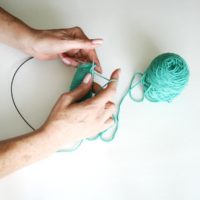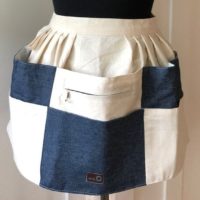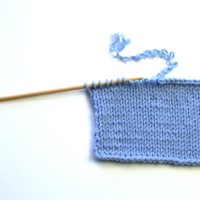Instructions for working this bind-off:
Set yourself up so you’re ready to work a wrong-side row. With the right-side of the work facing you, and the tail end of the yarn coming from the left side of the work, break the yarn, leaving yourself a tail that is at least twice the length of the width of the work. Thread the tail end on to a tapestry needle.
*Working from left to right, skip the first stitch. Go in to the second stitch as if to purl (from right to left), then through the first stitch the same way. Paying careful attention to tension, pull the working yarn tight, and slip the first stitch off the end of the needle.* Repeat between the *s to the last stitch. Put the needle in as if to purl, tighten, and weave in the end to finish.
Information on things you’ll see in this video:
The sweater on the mannequin is my Ombre Dyed Sweater, pattern + video tutorial.
The bulky yarn I used for demonstration is Lion Brand Hometown USA. I demonstrated using size 13 US (9mm) needles.
The needles I used are bamboo, made by Clover.





Just love it; thanks do much for sharing this bind off!!
This bind off looks like it would be great for the bottom of a top down sweater or any large project. Thanks
I wonder if it might be easier to maintain proper tension if, at the bind off point, several bound off stitches were kept on the needle instead of immediately dropping them off.
Staci, do you think this bind off would work well for the neck of a sweater?
If not, what bind off would you recommend?
Hi Tina – yes, this BO would work very well for the neck of a sweater. In fact, I just used it on the cowl neck of a poncho. It looks good, and it has plenty of stretch.
S t a c i
Reading through the directions for this bind off, it sounds similar to Elizabeth Zimmerman’s sewn bind off. Does it look like it too?
Kay – this is different than the Sewn Bind-Off (I have a video on that technique, too). This BO is really all about the look, and matching it to the cast-on. The Sewn BO is different looking, and all about the stretch.
S t a c i
I would never be able to control the tension well enough to produce a uniform bind-off. Couldn’t you get a similar effect by using the provisional cast-on but treat it as a permanent cast-on; i.e., use the working yarn without any extra chains at the ends. The cast-on edge would have a row of v’s. Then a regular bind-off would also give a row of v’s, and the two would look the same.
There is a bind off I do not know the name of it but you knit 2 together and the stitch you get on the left needle you put back on the right needle. You repeat this step until you have one stitch left and cut the yarn.